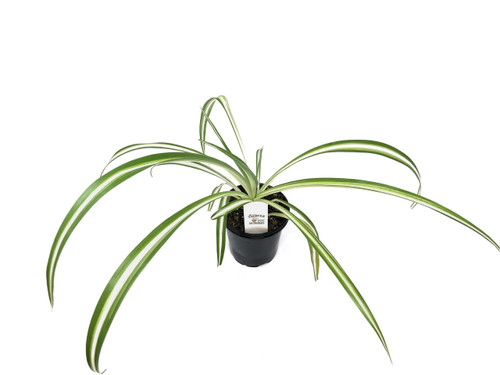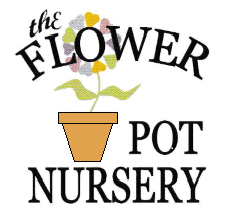Spider Plant / Airplane Plant - Chlorophytum comosum- 4” Pot 2 Cultivars
Chlorophytum comosum, often called spider plant but also known as airplane plant, St. Bernard's lily, spider ivy, ribbon plant, and hen and chickens is a flowering perennial herb. It is native to tropical and southern Africa, but has become naturalized in other parts of the world, including western Australia. Chlorophytum comosum is easy to grow as a houseplant; variegated forms are the most popular.
Description
Chlorophytum comosum grows to about 60 centimetres (24 in) high. It has fleshy, tuberous roots, about 5–10 cm (2–4 in) long. The long narrow leaves reach a length of 20–45 cm (8–18 in) and are around 6–25 millimetres (0.2–1.0 in) wide.
Flower of Chlorophytum comosum 'Vittatum'
Flowers are produced in a long branched inflorescence, which can reach a length of up to 75 cm (30 in) and eventually bends downwards. Flowers initially occur in clusters of 1–6 at intervals along the stem (scape) of the inflorescence. Each cluster is at the base of a bract, which ranges from 2–8 cm (0.8–3.1 in) in length, becoming smaller towards the end of the inflorescence. Most of the flowers which are produced initially die off, so that the inflorescences are relatively sparsely flowered.
Individual flowers are greenish-white, borne on stalks (pedicels) some 4–8 mm (0.2–0.3 in) long. Each flower has six three-veined tepals which are 6–9 mm (0.2–0.4 in) long, slightly hooded or boat-shaped at their tips. The stamens consist of a pollen-producing anther about 3.5 mm (0.1 in) long with a filament about the same length or slightly longer. The central style is 3–8 mm (0.1–0.3 in) long. Seeds are produced in a capsule 3–8 mm (0.1–0.3 in) long on stalks (pedicels) which lengthen to up to 12 mm (0.5 in).
The inflorescences carry plantlets at the tips of their branches, which eventually droop and touch the soil, developing adventitious roots. The stems (scapes) of the inflorescence are called "stolons" in some sources, but this term is more correctly used for stems which do not bear flowers, and have roots at the nodes.
Taxonomy
Chlorophytum comosum was first formally described by the Swedish naturalist Carl Peter Thunberg as Anthericum comosum in the 1794 volume of Prodromus Plantarum Capensium, Thunberg's work on the plants of South Africa. It was subsequently moved to a number of different genera, including Phalangium, Caesia, Hartwegia Nees and Hollia, before receiving its current placement in Chlorophytum by Jacques in 1862.
The species has been confused with Chlorophytum capense (L.) Voss by some authors, but this is a different species.
Intra-specific variation
There are three described varieties of the species: the autonym C. comosum var. comosum has strap-shaped narrow leaves and is found along forest margins, C. comosum var. bipindense has broader, petiolate leaves with stripes on the underside and the inflorescences are 2-3 times the length of the leaves, and C. comosum var. sparsiflorum also has broader leaves that narrow to the base and usually lacks a petiole and the striping on the underside of the leaf and the inflorescences are up to two times the length of the leaves. The latter two are rain fores
Spider Plant / Airplane Plant - Chlorophytum comosum- 4” Pot 2 Cultivars
MSRP:
Was:
Now:
(Inc. Tax)
MSRP:
Was:
Now:
$5.99
(You save
)
(No reviews yet)
Write a Review

Write a Review

Spider Plant / Airplane Plant - Chlorophytum comosum- 4” Pot 2 Cultivars
- SKU:
- UPC:

The Flower Pot Nursery
FlowerPotNursery Spider Plant Variegated Chlorophytum comosum Variegatum 4" Pot
MSRP:
Was:
Now:
(Inc. Tax)
MSRP:
Was:
Now:
$8.99

Add to Cart
The item has been added
The Flower Pot Nursery
FlowerPotNursery Spider Plant Inverted Chlorophytum comosum Inverted 4" Pot
MSRP:
Was:
Now:
(Inc. Tax)
MSRP:
Was:
Now:
$9.58

The Flower Pot Nursery
FlowerPotNursery Irish Spider Plant Chlorophytum comosum Irish 10" Basket
MSRP:
Was:
Now:
(Inc. Tax)
MSRP:
Was:
Now:
$21.99

Add to Cart
The item has been added
The Flower Pot Nursery
FlowerPotNursery Irish Spider Plant Chlorophytum comosum Irish 8" Basket
MSRP:
Was:
Now:
(Inc. Tax)
MSRP:
Was:
Now:
$25.18

The Flower Pot Nursery
FlowerPotNursery Variegated Irish Spider Chlorophytum comosum V. Irish 4" Pot
MSRP:
Was:
Now:
(Inc. Tax)
MSRP:
Was:
Now:
$5.99
!


